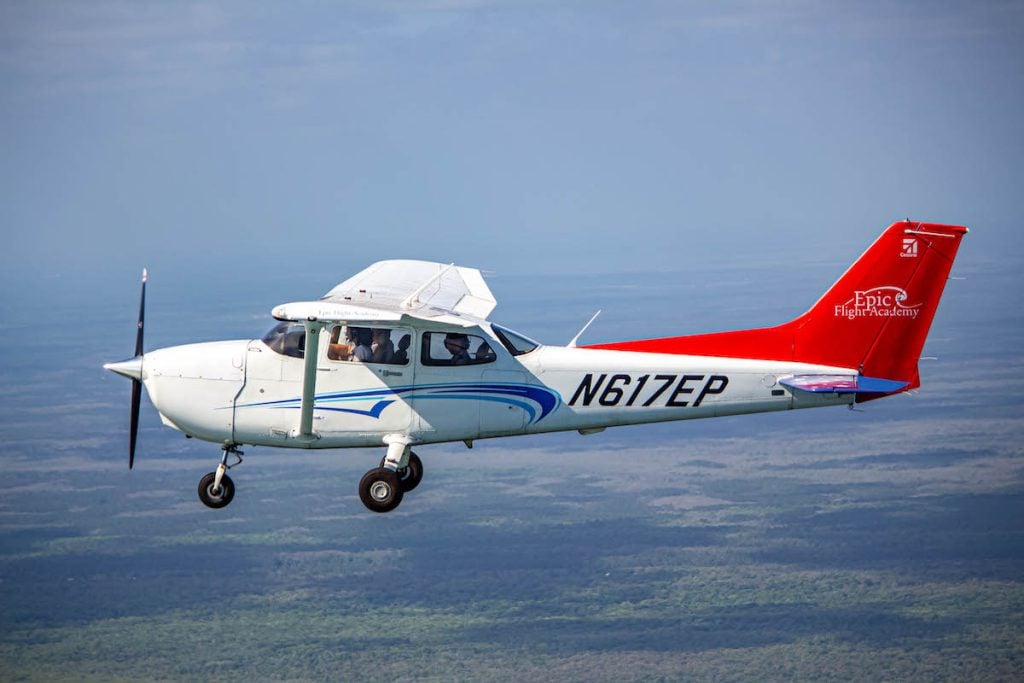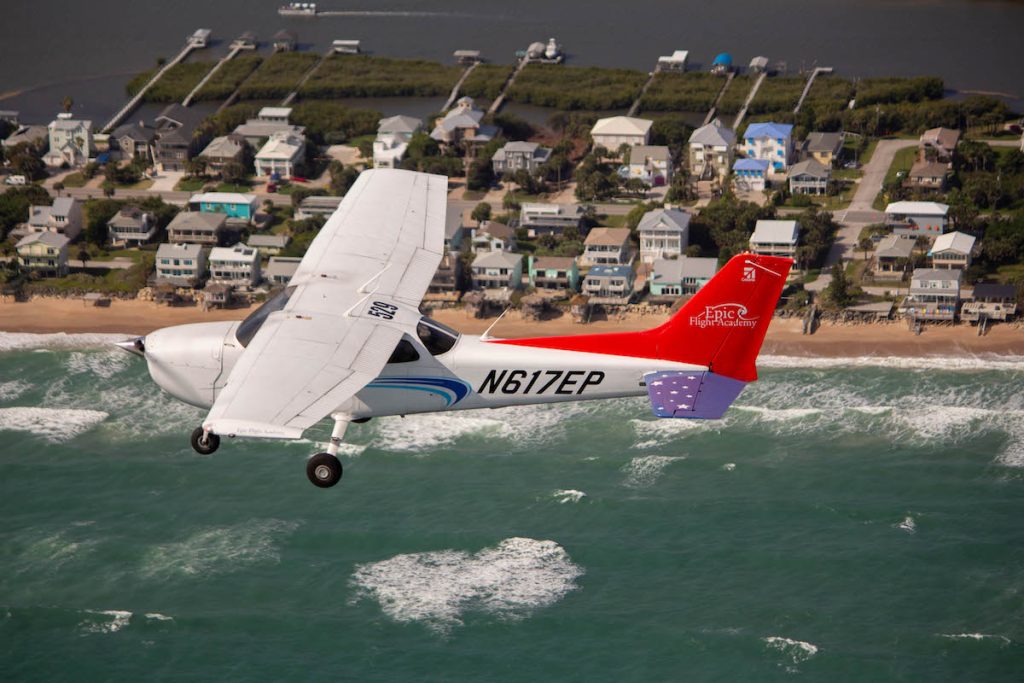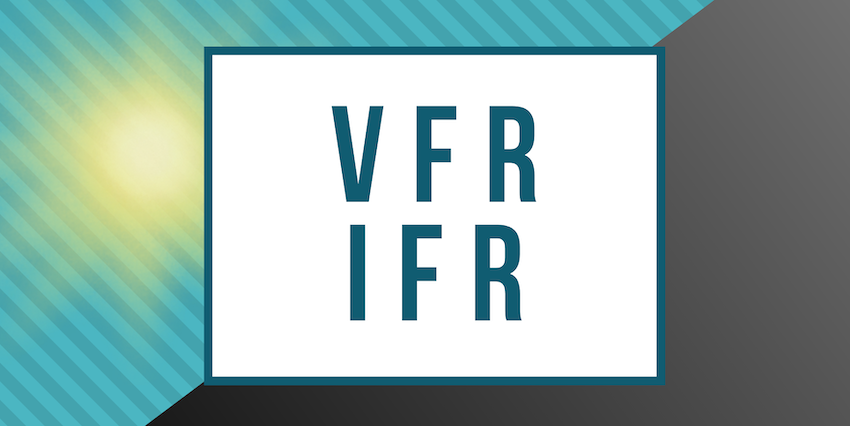What is the difference between VFR and IFR pilot ratings?
The short answer is: VFR pilots can only fly in good visibility. IFR pilots can fly when visibility is poor.
What do the terms “VFR” and “IFR” mean?
The acronyms VFR and IFR stand for different types of FAA pilot certifications. VFR stands for “Visual Flight Rules.” This means that a VFR-rated pilot must follow specific guidelines when flying using visual references. A pilot holding a Private Pilot License (PPL) must fly in VFR conditions.
IFR stands for “Instrument Flight Rules” and allows a pilot who is Instrument Rated (IR) to operate an aircraft by relying almost solely on instruments. Once a pilot holds a PPL, the next step is to be Instrument Rated (IR). This allows the pilot to fly IFR. Every aspect of flying is impacted by these ratings, such as flight planning, taking off, navigation, weather tracking, flight following, radar, and landing.
VFR Pilot: Visual Flight Rules

VFR Pilot Information
When you first begin as a pilot, you will be flying under a VFR pilot rating. This means you will fly using visual references. For instance, you’ll look for landmarks, highways, bodies of water, etc. Pilots are also on the lookout for other aircraft so they can see and avoid them. VFR pilots are dependent upon the weather. Therefore, they must actively watch for any sudden changes that could present low visibility or other dangerous situations. VFR flying is for fair weather days only.
VFR Flight Requirements
Criteria for VFR deal with the plane’s fuel allowances and pilot visibility. They also include general distance from ground, distance from clouds, and avoiding the possibility of flying in inclement weather. Pilots must adhere to VFR weather minimums at all times. In order to avoid potentially dangerous situations, pilots can make no exceptions. For instance, VFR pilots must be able to see clearly for 3 statute miles. Also, in most cases, they must remain 500 feet below clouds or 1,000 feet above clouds. During this time, they also maintain 2,000 feet horizontal distance from clouds. Furthermore, the FAA publishes detailed guidelines.
Visual Meteorological Conditions (VMC) are those weather conditions that meet minimum conditions. When these conditions are not met, they are called Instrument Meteorological Conditions (IMC).
Basic VFR requirements and flight procedures cover:
- Fuel requirements
- VFR Flight Plan
- Basic VFR weather minimums
- Special VFR weather minimums
- VFR cruising altitude/flight level
- Special awareness training
IFR Pilot: Instrument Flight Rules

IFR Pilot Information
After earning your Private Pilot License (PPL) with your VFR rating, you are ready to become Instrument Rated (IR) where you will train to fly in IFR (Instrument Flight Rules) conditions. FAA guidelines for IFR protect pilots from accidents caused in conditions of poor visibility. IFR pilots rely on Air Traffic Control (ATC) for instructions. They file IFR flight plans and rely on their instruments for navigation. Specialized IR classes cover Instrument Rating requirements and require candidates to pass an FAA IR exam and check-ride.
IFR Flight Requirements
More than half of all private pilots go on to become instrument rated. Besides flying in poor weather conditions, IFR flight offers other advantages. The level of skill is increased, and IFR pilots are always “two steps ahead” in the plane, which creates a safer environment. IFR pilots are better able to analyze weather and anticipate what to do next. Navigation is also improved in IFR flight, because ATC is providing specific guidance and can offer slight tweaks to your course to help you avert rough weather. CFIIs train pilots to safely fly IMC. They are also trained to know when it’s best to remain on the ground.
Basic IFR Requirements and Flight Procedures Cover
- Fuel requirements
- IFR Flight Plan and Pre-flight preparation
- VOR Equipment Check
- IFR Flight Plan Filed with ATC
- IFR Take-off and landing (Visibility Limitations)
- Minimum Altitudes and Distances for IFR operations
- IFR Flight Levels, Altitudes, and Cruising Speeds
- Flight Path Clearances
- IFR Communications and Communication Failures
- IFR Malfunction Reporting in Controlled Airspace
- Special Air Space General Operating Procedures
- Closing Flight Plan after completed flight
Most Importantly, when you are flying under IFR, you are flying by using nothing but your instruments, your ears, and your wits. You will rely on Air Traffic Control (ATC) for communication and instructions. You will rely on your instruments for navigation, weather, and other important information. And, you will rely on your wits by remaining focused and calm in the cockpit as you fly a plane in visibility that may end at your windshield.
IFR courses involve specialized training, often in a flight simulator and sometimes ‘under the hood’ in the aircraft alongside a Certified Flight Instrument Instructor. Your training will culminate with a written exam and check-ride.
What Are Glass Cockpits?

A glass cockpit refers to the instrument panel of an aircraft that uses electronic flight instrument displays on large LED displays. Newer aircraft feature multi-function displays. Pilots prefer them over the traditional analog instruments. Airlines rely on glass cockpits to free up pilots’ attention to focus on the most pertinent information. Also, glass cockpits support both VFR and IFR flights. For airlines, they typically replace the need for a flight engineer. Glass cockpits commonly integrate GPS receivers.


What % of pilots are IFR rated?
More than half are IFR
Very good info. Lucky me I ran across your website by accident (stumbleupon).
I’ve book marked it for later!